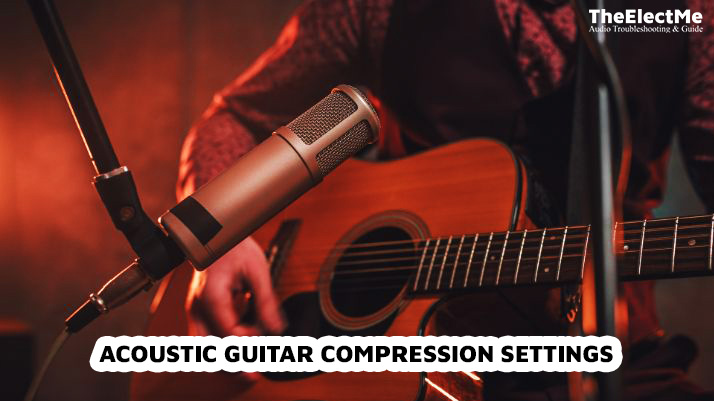Acoustic guitars bring a unique touch to music with their rich, resonant sound. Getting that perfect acoustic guitar sound can be tricky. This is where the role of compression becomes crucial.
In the world of acoustic guitars, compression is like a secret enhancer. It doesn’t just amplify the softer parts and tone down the louder ones. It subtly brings out the hidden nuances in an acoustic guitar performance, providing a refined, professional touch.

Acoustic guitar compression settings can drastically uplift the quality of your guitar sound. It helps manage the sound dynamics, bridging the gap between loud and soft notes and adding a punch to your performance. The result? A more balanced, consistent, and vibrant acoustic guitar sound that shines in any mix.
But how do you optimize your acoustic guitar compression settings to achieve that incredible sound? Let’s dive into some tips and techniques that work for any guitarist, whether a beginner or an experienced pro.
What Parameters Must You Focus On Before Doing Acoustic Guitar Compression Settings?
Regarding compression settings for acoustic guitars, there are a few key parameters to consider. Here’s a guide to help you navigate through these settings:
Optimal Ratio for Acoustic Guitar Compression
The ratio is a fundamental aspect of compression. It determines how much the volume will be reduced once it surpasses the threshold.
A good starting point for an acoustic guitar is a 2:1 – 4:1 ratio. This means that for every 2 to 4 dB above the threshold, the output will increase by only 1 dB.
For more advanced players, a 6:1 ratio can be used. This higher ratio results in more robust compression, which can help control louder strumming or picking techniques.
Configuring Attack and Release Times
Another crucial part of compression is adjusting the attack and release times. The attack time is how quickly the compressor responds to the sound exceeding the threshold. A longer attack time lets the initial note pass before the compressor engages, preserving the guitar’s natural feel.
The release time is the speed at which the compressor stops compressing when the sound drops below the threshold.
The ideal release time can vary based on your music’s tempo and rhythm, requiring experimentation. Set the compressor’s release time to stop compressing between note or chord strikes.
These are just starting points; each guitar body, player, and song may require different settings. The key is to listen carefully and adjust according to what suits the music best.
After focusing on these parameters, let’s move to the step-by-step process for setting your acoustic guitar compression:

Step-by-step Guide to Optimizing Acoustic Guitar Compression Settings
Once you have a good understanding of the different parameters involved, it’s time to dive into the process of setting up your acoustic guitar compressor.
Setting the Threshold and Ratio
- Start by setting a low threshold and a high ratio (like 10:1). This will make the compressor very responsive, compressing nearly everything played. It’s an extreme setting, but it helps understand what the compressor does.
- Play your guitar and listen to how it sounds. You should notice that the sound becomes more consistent but also less dynamic. The louder parts should be quieter, and the softer parts should be louder.
- Gradually adjust the threshold upwards until only the loudest parts of your performance are compressed. You can see this on the gain reduction meter on your compressor.
- Next, start reducing the ratio. A ratio of around 2:1 – 4:1 is a good starting point for most acoustic guitar applications. However, experiment to find what works best for your playing style.
Fine-tuning the Attack
After you’ve set the threshold and ratio, it’s time to fine-tune the attack time. Start with a slow attack (around 25ms) and play a few chords. Listen to the blooming notes – a noticeable punch at the start of each note before the compressor kicks in.
Gradually reduce the attack time. The punch at the start of each note should become less noticeable, and the overall sound might seem more controlled.
Evaluating Performance for Dynamics, Tone, and Timbre
Finally, it’s crucial to evaluate the overall performance. Play a variety of styles – strumming, fingerpicking, soloing – and listen to how the compressed sound compares to the uncompressed sound. Pay attention to the dynamics, tone, and timbre of the guitar.
Does the compressed sound have the same warmth and depth as the uncompressed sound? Does it feel dynamic, or does it feel too controlled? These are the questions you need to consider when fine-tuning your compression settings.
Remember, the goal is not to make the sound as consistent as possible.
Instead, it’s about enhancing the natural characteristics of the acoustic guitar while controlling the extremes in dynamics. So, feel free to experiment and tweak the settings until you find what works best for your sound.
After following these steps, you should understand how to optimize your acoustic guitar compression settings. You can also refresh your guitar for a better sound. How to refresh the guitar, click to explore the techniques to refresh your guitar.
Let’s move to the final topic: common mistakes to avoid when compressing your acoustic guitar.

Common Mistakes To Avoid When Compressing Acoustic Guitar
When it comes to compression, there are a few common mistakes that many guitarists make. Here are some things to avoid when dialing in your acoustic guitar compression settings:
- Using too much compression: While compression can significantly enhance the sound of an acoustic guitar, it can lead to a dull, lifeless sound. Be mindful of your settings and adjust them accordingly.
- Not considering the tempo and rhythm: As mentioned earlier, the release time should be set to the music’s tempo and rhythm. If you don’t think this, the compressed sound may not match the natural pace of the song.
- Ignoring individual playing styles: Every guitarist has a unique playing style, and the compression settings should reflect that. Please don’t rely on generic settings; tailor them to your specific guitar and playing style.
- Not listening carefully: The most crucial aspect of setting acoustic guitar compression is listening carefully. Take the time to experiment and find what works best for you – don’t just rely on recommended settings.
Follow these tips to optimize your acoustic guitar compression settings and achieve a balanced, dynamic sound in your recordings and performances.
Conclusion – Acoustic Guitar Compression Settings
To conclude, compression is a powerful tool for enhancing the sound of your acoustic guitar. Understanding parameters and their impact on sound enhances settings for a balanced, dynamic sound that suits your play style.
Here are three takeaways to remember when setting acoustic guitar compression:
- Start with extreme settings and gradually adjust until you find the right balance for your sound.
- Pay attention to the tempo, rhythm, and individual playing style when fine-tuning release and attack times.
- Always listen carefully, and don’t be afraid to experiment to find what works best for your sound.
With these tips, you can confidently dial in your acoustic guitar compression settings and take your recordings and performances to the next level. Keep practicing, listening, and fine-tuning to achieve a polished, professional sound that will make your music shine.



